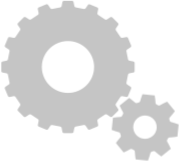
Recommended RPM Speed for Hole Saws
Do's and Don'ts of Hole Saw Operation
- DO Operate hole saw at recommended speed. See RPM table.
- DO Apply sufficient pressure to cause continuous chip formation.
- DO Set pilot drill far enough (about 1/8") beyond cutting edge of the saw to establish and maintain a solid center.
- DO Use cutting oil or coolant to assure cleaner, cooler cuts and longer blade life.
- DO Chuck the hole saw properly.
- DO Hold the saw perpendicular to the surface of the material being cut.
- DO Hold the hole saw drive unit firmly. A drill press or lathe is best when possible.
- DO Be sure that drive pins on pin drive arbors are properly engaged.
- DO Wear safety glasses and keep idle hands away from the sawing operation.
- DON'T Run the hole saw too fast. Excessive speed will cause premature wear.
- DON'T Allow the tooth tips to rub across the surface of the work. Rubbing increases heat, dulls teeth, and will work harden some materials.
- DON'T Operate a hole saw without a pilot drill or with a pilot drill set too shallow.
- DON'T Operate a hole saw dry (except in cast iron). Dry cuts generate more heat and decrease the life of the hole saw.
- DON'T Chuck the hole saw too loosely or off center.
- DON'T Try to saw holes at an angle to the work surface. If the teeth contact the work unevenly, the hole saw will twist off center and break the pilot drill or saw.
- DON'T Allow the hole saw and drive unit to wobble or orbit around the pilot drill. This can cause the hole saw to jam or skip resulting in breakage.
- DON'T Allow the drive pins to become loose and disengage from the hole saw cap.
- DON'T Let loose clothing or long hair get near a revolving hole saw.
CAUTION: Failure to operate tool correctly may result in tool breakage or bodily injury.
|
||||||||||||||||||||||||||||||||||||||||||||||||||||||||||||||||||||||||||||||||||||||||||||||||||||||||||||||||||||||||||||||||||||||||||||||||||||||||||||||||||||||||||||||||||||||||||||||||||||||||||||||||||||||||||||||||||||||||||||||||||||
|
||||||||||||||||||||||||||||||||||||||||||||||||||||||||||||||||||||||||||||||||||||||||||||||||||||||||||||||||||||||||||||||||||||||||||||||||||||||||||||||||||||||||||||||||||||||||||||||||||||||||||||||||||||||||||||||||||||||||||||||||||||||||||||||||||||||||||||||||||||||||||||||||||||||||||||||||||||||||||||||||||||||||||||||||||||||||||||||||||||||||||||||||||||||||||||||||
Filter
Choose a category
- Low Pressure Gas Plugs, 154 Series
- Multi-Flex® High Expansion Gas Bag Style Pipe Plug, 113 Series
- Multi-Flex® High Pressure Block & Bleed Plugs, 127BB Series
- Multi-Flex® High Pressure Hydrocarbon Resistant Inflatable Pipe Plugs, 127 Series
- Multi-Flex® Oil Resistant With & Without Bypass Pipe Plug, 114-115 Series
- Multi-Flex® Oil-Resistant Heavy-Duty Pipe Plug, With & Without By-Pass, 124-125 Series
- Municipal Style By-pass Plugs Sizes, 130-2 Series
- PeteStop® Pipe Plug, Inflatable Flow Stop, 129-8 Series
- PeteStop® Pipe Plug, Inflatable Line Stop, 128 Series
- PeteStop® Pipe Plug, Inflatable Line Stop, 129 Series
- Point Repair Packer Carrier with & without By-Pass, 130-5 Series
- Rigid Core Remote Placement Bore Hole Plugs & Packers, 126 Series
- Rubber Aramid Reinforced Pipe Plugs, 136 Series
- Rubber Leak Detector Test Plugs, 130-4 Series
- Rubber Long Test Plugs, 130-3 Series
- Rubber Pillow Style Test Ball Plugs, 130-9 Series
- Rubber Plugs with Large Flow-Through By-Pass,130-6 Series
- Rubber Plumber Test Plugs, 130-0 Series
- Rubber Plumber Test Plugs, With & Without By-Pass, 137 Series
- Rubber Remote Placement Plugs, 130-7 Series
- Rubber Stack Test Plugs, 130-1 Series
- Through the Valve Line Stop
- Effluent Pumps & Accessories
- Hose Assemblies
- Inflation Controllers For Pipe Plugs and Packers - 936 Series
- Mechanical Plug Safety Gags, 936-5 Series
- Pipe Plug Inflation Accessories
- Pipe Plugs and Packers Accessories Pull Cages, 936 Series
- Rotating Elbows for Gas and Fluid Systems, 936 Series Petersen®
- ABS & SS Threaded Pipe End Test Plug, 143-8 Series
- ABS End of Pipe Gripper Plug, 143-9 Series
- Bolt Type High Pressure Test Plugs, 147 Series
- Bolt Type Medium Pressure Test Plugs With By-Pass, 146-9 Series
- Custom Mechanical Plugs, 145-2 Series
- EZ-Swet Mechanical Line Stopper Plugs, 148-0 Series
- Flush Mounted & Beveled Finishing Plate Plugs, 140-4 & 140-5 Series
- Hand Tightening Aluminum Body Flexible Double Test Plugs, 149-2 Series
- Hand Tightening Aluminum Body Test Plugs With By-Pass, 149-1 Series
- Hand Tightening Double Seal Wing Nut, 141-2 Series
- Hand Tightening Low Pressure Aluminum Body By-Pass Plugs, 141 Series
- Hand Tightening Low Pressure Nylon Plug, 144 Series
- Hand Tightening Nylon Pipe Plug, 142-0 Series
- Hand Tightening Nylon Test & Cleanout Plugs, 143-0 Series
- High Impact ABS Wing Nut Plug, 144-1 Series
- High Lift Flange Weld Test Plugs, 151-Series
- High PSI Double Block & Bleed Single Actuator, 145-1 Series
- Lever Type Expandable Rubber Plugs, 143-1 Series
- Mechanical High Pressure Test Plugs, 145-9 Series
- Monitor Well Plugs, 142-8 Series
- Pipe Protector Bell or Spigot End, 140 Series
- Pipeline Joint Tester, 24in to 120in, 145-8 Series
- Polypropylene End of Pipe Plugs, 143-4 Series
- Remote Placement Expander Plugs,148-3 Series
- Rubber Seal Mechanical Pipe Plugs, 143-2 Series
- Steel Wing Nut Pipe Plugs, 143-3 Series
- T-Handle Aluminum Test Plugs with & without By-Pass, 143-7 Series
- Tapered Redwood Pipe Plugs, 140-1 Series
- Test Caps, 142-9 Series
- Water Line Stub Plugs, 143-5 Series
- Wing Nut Hand Tight Test Plugs, 141-1 Series
- High Pressure Portable Hydrostatic Test Pumps, 938-9 Series
- Hydrostatic Test Pumps, 938-93 Series
- Leak Detector Pressure Testing, 924-1304 Series
- Leak Detector Pressure Testing, 924-1304 Series
- Manhole Vacuum Test Equipment, 938-7 Series
- Parachutes, Stringers, Ventilators, Smoke Blowers
- Pipeline Deflection Gauges, 938-96 Series
- Pipeline Joint Testers, Sizes 24" to 120", 145-8 Series
- Smoke Testers, 938-95 Series
- Smoke Testers, 938-95 Series







